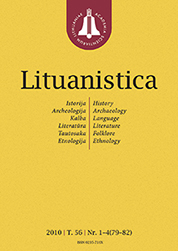LituanisticaWHAT?
 ISSN 0235-716X |
2005 m. Nr. 2 Ar buvo polinių gyvenviečių akmens amžiuje Lietuvoje?
Seven pile dwelling sites are presently known in Lithuania. Like in the entire band of moraine from the last Ice Age, the Neolithic-Early Bronze Age, the inhabitants built pile buildings at the junctions of lakes and lagoons for the purposes of extracting food and
protection. Pile dwelling sites were erected on platforms raised over water, which were built on poles pounded into the soft clay of lakes or lagoons. This statement is confirmed by the pattern of poles along lake shores and the spread of finds about pile dwelling sites and their position in the cultural layer. The existence of pile dwellings is testified by the fact that no fireplaces are discovered in the dwelling sites and that large rubbish heaps are found beside pile buildings. Pile dwellings were inhabited year-round. Pile buildings were important in respect to the community’s safety. Some of them, e.g., the Žemaitiškė 1 dweling site, were protected on the dry side by palisades and ditches. In the territory of Lithuania, communities of the Narva culture, whose economic activity was fishing, lived in pile dwelling sites. This fact is confirmed by barriers for catching fish, fish pots, nets with floats and plummets, and individual fishing tols (fishing spears and hooks discovered beside the pile buildings). In the territory of West Lithuania, pile structures were used by Globular Amphore and Corded Ware Cultures and in North-east Lithuania by communities of Comb-pit Ware Culture. |
Numeriai:
2011 - T.57 Nr.1, Nr.2, Nr.3, Nr.4 2010 - T.56 Nr.1-4 2009 - T.55 Nr.1-2, Nr.3-4 2008 - T.54 Nr.1, Nr.2, Nr.3, Nr.4 2007 - T.53 Nr.1, Nr.2, Nr.3, Nr.4 2006 Nr.1, Nr.2, Nr.3, Nr.4 2005 Nr.1, Nr.2, Nr.3, Nr.4 2004 Nr.1, Nr.2, Nr.3, Nr.4 2003 Nr.1, Nr.2, Nr.3, Nr.4 2002 Nr.1, Nr.2, Nr.3, Nr.4 2001 Nr.1, Nr.2, Nr.3, Nr.4 |